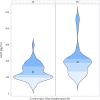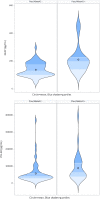Inflammatory plasma biomarkers in subjects with preclinical Alzheimer's disease
- PMID: 35922871
- PMCID: PMC9347121
- DOI: 10.1186/s13195-022-01051-2
Inflammatory plasma biomarkers in subjects with preclinical Alzheimer's disease
Abstract
Background: This study investigated plasma biomarkers for neuroinflammation associated with Alzheimer's disease (AD) in subjects with preclinical AD compared to healthy elderly. How these biomarkers behave in patients with AD, compared to healthy elderly is well known, but determining these in subjects with preclinical AD is not and will add information related to the onset of AD. When found to be different in preclinical AD, these inflammatory biomarkers may be used to select preclinical AD subjects who are most likely to develop AD, to participate in clinical trials with new disease-modifying drugs.
Methods: Healthy elderly (n= 50; age 71.9; MMSE >24) and subjects with preclinical AD (n=50; age 73.4; MMSE >24) defined by CSF Aβ1-42 levels < 1000 pg/mL were included. Four neuroinflammatory biomarkers were determined in plasma, GFAP, YKL-40, MCP-1, and eotaxin-1. Differences in biomarker outcomes were compared using ANCOVA. Subject characteristics age, gender, and APOE ε4 status were reported per group and were covariates in the ANCOVA. Least square means were calculated for all 4 inflammatory biomarkers using both the Aβ+/Aβ- cutoff and Ptau/Aβ1-42 ratio.
Results: The mean (standard deviation, SD) age of the subjects (n=100) was 72.6 (4.6) years old with 62 male and 38 female subjects. Mean (SD) overall MMSE score was 28.7 (0.49) and 32 subjects were APOE ε4 carriers. The number of subjects in the different APOE ε4 status categories differed significantly between the Aβ+ and Aβ- groups. Plasma GFAP concentration was significantly higher in the Aβ+ group compared to the Aβ- group with significant covariates age and sex, variables that also correlated significantly with GFAP.
Conclusion: GFAP was significantly higher in subjects with preclinical AD compared to healthy elderly which agrees with previous studies. When defining preclinical AD based on the Ptau181/Aβ1-42 ratio, YKL-40 was also significantly different between groups. This could indicate that GFAP and YKL-40 are more sensitive markers of the inflammatory process in response to the Aβ misfolding and aggregation that is ongoing as indicated by the lowered Aβ1-42 levels in the CSF. Characterizing subjects with preclinical AD using neuroinflammatory biomarkers is important for subject selection in new disease-modifying clinical trials.
Trial registration: ISRCTN.org identifier: ISRCTN79036545 (retrospectively registered).
Keywords: Eotaxin-1; GFAP; MCP-1; Neuroinflammation; Preclinical Alzheimer’s disease; YKL-40.
© 2022. The Author(s).
Conflict of interest statement
The authors declare that they have no competing interests.
Figures



References
-
- Bjorkli C, Sandvig A, Sandvig I. Bridging the gap between fluid biomarkers for Alzheimer’s disease, model systems, and patients. Frontiers in aging. Neuroscience. 2020;12(272). https://www.frontiersin.org/articles/10.3389/fnagi.2020.00272/full. - DOI - PMC - PubMed
Publication types
MeSH terms
Substances
Associated data
LinkOut - more resources
Full Text Sources
Medical
Miscellaneous

